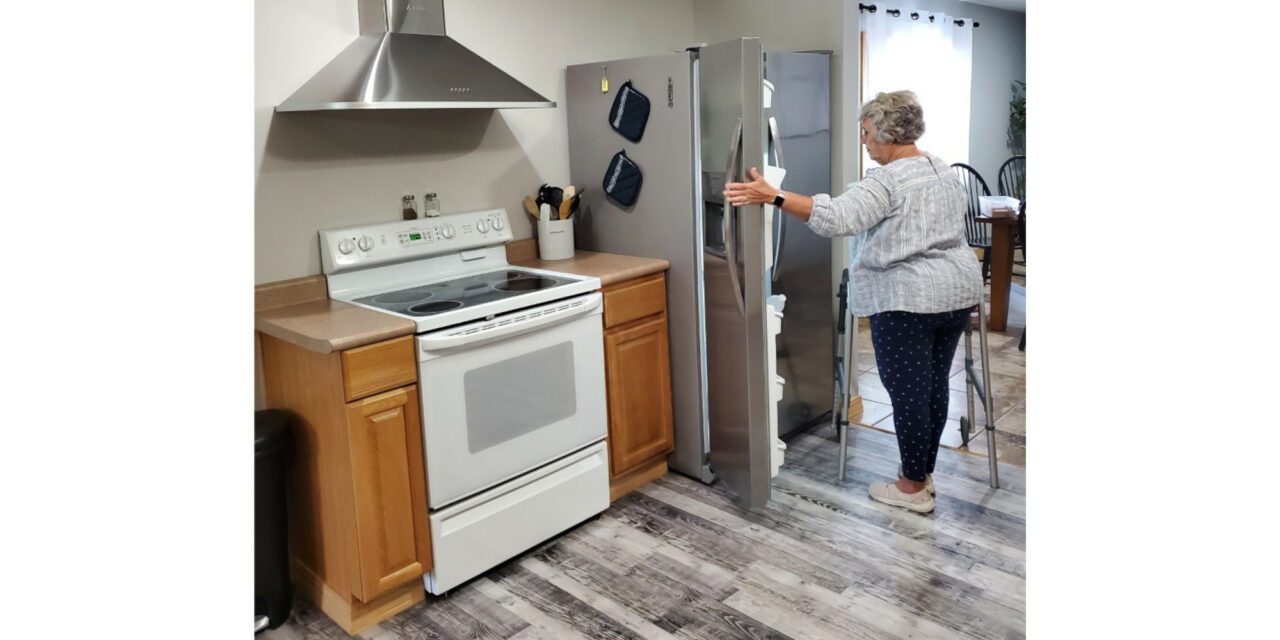With an organized approach, occupational therapists can help clients evaluate and overcome barriers using home modification for aging in place.
by Kirsten Davin, OTD, OTR/L, ATP, SMS
While aging in place may seem to be an easily defined concept, having the opportunity to age within your home and community may not be as easy as it appears, especially in the presence of chronic or progressive illness.
The US Centers for Disease Control and Prevention defines aging in place as the ability to live in one’s own home and community safely, independently, and comfortably, regardless of age, income, or ability level. In recent years, organizations around the globe have implemented healthy aging initiatives designed to establish and drive dramatic improvements in the quality of life for all during the aging process. One key component to this is aging in place.
Data from various resources suggests that for many older Americans, aging in place is a worthy goal. They may want to remain in the home and community they are familiar with, often because of strong sentimental ties and generational bonds. But sometimes financial limitations, physical barriers, or reduced social and familial support pose a challenge to achieving this desire. Occupational therapists can help their clients navigate these issues so they can safely stay in their homes.
Considerations for Success
Successful components for aging in place are threefold, and include the person, the environment, and the available network of support. When attempting to determine if aging in place can successfully be achieved, each of these overreaching components as well as the factors contained within should be carefully considered.
Factors including but not limited to a client’s current healthcare status and future prognosis as well as access to hospitals and physicians should be considered when determining the feasibility of aging in place. Finances can also be a factor, especially if a client will require in-home care in the future for assistance with activities of daily living, meal preparation, medication management, or other household tasks.
It is important to consider both a client’s home and community when evaluating the feasibility of their aging in place. Physical barriers, both within the home and out in the community, not only can pose a challenge to achieving and maintaining independent living but can also pose a significant threat to safety and well-being. This is especially true if the client presents with visual impairment, generalized weakness, or difficulty with mobility.
As in all phases of a person’s life, a strong support system is beneficial. When barriers arise during aging, including the inability to drive a vehicle or navigate certain environments either within the home or community (ie, grocery store, physician’s office), it may lead to a need for a strong support network. This network often consists of family or friends, but if neither is available, it may include paid attendants and in-home caregivers. Clients should consider making use of community-based support organizations such as meal delivery services as well.
Check Physical Barriers Off the List
One of the most common barriers to aging in place is the physical environment in which a person resides. A home that was built or purchased 10, 20, or 60 years ago during a client’s younger years may now pose a challenge to independence. While some physical barriers may be more obvious—including stairs at the entryway, laundry facilities located in the basement, or narrow hallways and doors—others may be more difficult to identify. A home safety checklist, ideally combined with an in-home assessment by an occupational therapist or certified aging-in-place specialist, may aid a client in achieving improved independence, a greater degree of safety including fall prevention, and increased efficiency in task performance.
The National Association of Home Builders has developed an Aging-In-Place Design Checklist, which provides insight and a quick reference guide for various aging-in-place issues within the home. Below is a sampling of checklist categories along with options to rectify the concern, often with a low-cost home modification.
Exterior
When exterior updates to the home are required, it’s best to consider low- or no-maintenance options that can stand the test of time and weather. Vinyl siding, decking, or ramp materials can significantly reduce the need for exterior updates. Repairing cracked or work surfaces such as sidewalks, porches, or garage floors to reduce the risk of falling is important as well. The implementation of low- or no-maintenance landscaping options can significantly reduce the risk of falling. An example may include replacing hard-to-care-for flower beds with low-maintenance rock beds containing durable, low-maintenance foliage.
While the bathroom is markedly the area within the home where people experience the most falls, a home’s exterior (ie, yard, exterior steps) can also pose a significant threat. Incorporating motion-sensor exterior lighting, including illumination specifically for the door lock and steps, is important to safety and can reduce the risk of falling.
Overall Floor Plan
When purchasing or constructing a home, especially later in life, it’s important to consider the overall floor plan and its feasibility to events related to aging in place. A main-floor living area, including laundry and a full bathroom, is important, as is the avoidance of steps within the main level. A popular building design a few decades ago was to create a “sunken” living room, which consisted of a step down from the adjoining rooms or hallways into the living room or common area. These sunken rooms can pose a significant fall risk and hardship to those who present with mobility limitations or decreased balance.
Sunken rooms, uneven thresholds, and variance in floor coverings can also lead to challenges with walker use or wheelchair propulsion should either be necessary while aging in place. For safe and effective wheelchair use within the home, each room should have a clear, open space of 5 feet by 5 feet to allow for full wheelchair access and maneuverability along with flush interior thresholds and beveled exterior thresholds.
Home Organization
Sometimes, it is not the design of the home but the items within the home that create a safety issue or fall risk. It’s essential to carefully assess a home’s current organization as well as whether there is a need for clutter reduction or new, more effective organization methods to ensure ease in access to necessary items and to maintain a clear path of mobility.
Bathroom
Careful consideration should be paid to the bathroom, as this is the site of the greatest occurrence of falls within the home. While some bathroom-related safety considerations may be inherent (ie, non-slip flooring in the bathroom and shower or tub, grab bars in the shower and near the toilet, hand-held shower head, and elevated toilet installation), other home modification ideas may be equally as important. If visual discrimination or vision limitations are present, consider contrasting colors or edging at the countertops or within the shower. Often, a bathroom environment that consists of a single color, often white, can pose a fall risk for elderly clients with vision limitations.
Lighting can be a crucial application within the bathroom as well. Consider the installation of recessed lighting within the shower space to better illuminate surfaces. Installing other components, such as toilet paper holders that can be changed with only one hand, can be a simple and cost-efficient adaptation that results in greater independence and fewer frustrations on behalf of the user.
Kitchen
Often overlooked, adequate lighting in the kitchen can be useful to prevent injury as well. Under-cabinet lighting, or focal lighting in areas of meal prep or knife use, can reduce the risk of injury and improve efficiency and ease in meal prep. Pull-down shelving can be installed in cabinets or pantries for ease in access, especially from wheelchair level if needed. For lower cabinets, pull-out shelving options can reduce the risk of falls by allowing the user to access items on the shelf while reducing the need to bend over or reach into a low cabinet. Appliances with high-contrast control panels may also be helpful to those who are experiencing vision limitations. If a simple adaptation is required, tactile stickers can be placed over the necessary or baseline control panel of the stove, oven, or dishwasher for ease of use.
Tech-Based Applications
Environmental control within the home has never been easier than it is in today’s age of technology. Simple to install and cost-efficient to purchase, wi-fi-based applications can assist the user in a multitude of tasks including locking and unlocking doors, automatically opening doors, adjusting the thermostat, ordering groceries, controlling lighting, opening and closing curtains, and improving safety within the home via camera or methods of fall notification. With an abundance of free and low-cost applications available, the possibilities are endless.
Utilizing Home Adaptations and Modifications
We are fortunate to live in an era in which a variety of home adaptations and modification concepts exist, especially tech-based applications, to make life at home easier and more efficient, even for those with chronic or progressive illness or mobility limitations that may accompany aging. For clients and therapists alike, when shopping for a new home or considering remodeling a current residence, it is important to remember that injury, illness, or limitations in independence can occur at any age for a multitude of reasons. Regardless of age, it’s prudent to consider universal design and potential applications that can be implemented in order to have a plan in place should home modification for improved independence be necessary.
For additional information on aging in place, to connect with a certified aging-in-place professional, or for full access to the National Association of Home Builders’ aging in place checklist, visit the website www.nahb.org.
Kirsten Davin, OTD, OTR/L, ATP, SMS, an occupational therapist of nearly 20 years and expert in the seating/positioning industry, currently serves as a clinical assistant professor and academic fieldwork coordinator for Baylor University’s OT Doctorate Program. For more information, contact [email protected].





